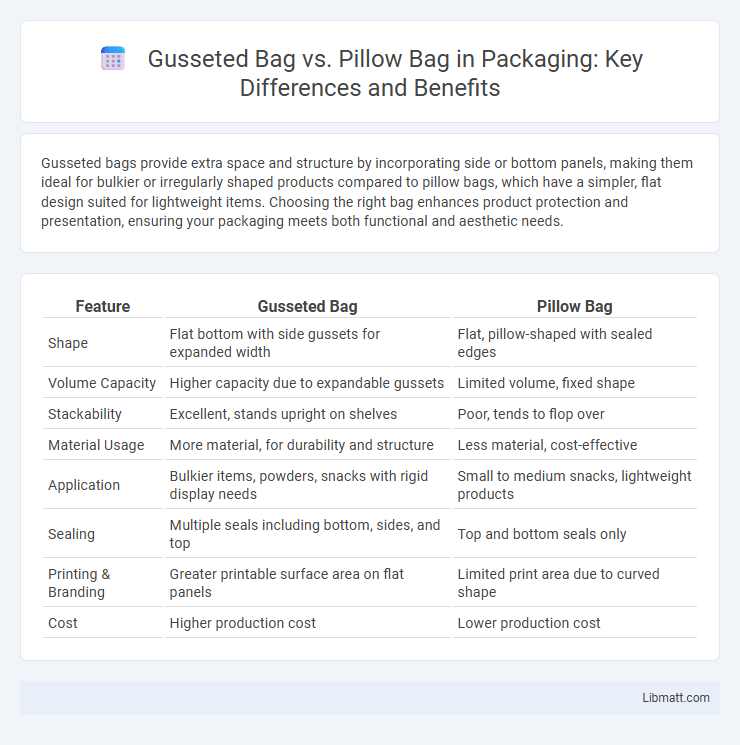Gusseted bags provide extra space and structure by incorporating side or bottom panels, making them ideal for bulkier or irregularly shaped products compared to pillow bags, which have a simpler, flat design suited for lightweight items. Choosing the right bag enhances product protection and presentation, ensuring your packaging meets both functional and aesthetic needs.
Table of Comparison
| Feature | Gusseted Bag | Pillow Bag |
|---|---|---|
| Shape | Flat bottom with side gussets for expanded width | Flat, pillow-shaped with sealed edges |
| Volume Capacity | Higher capacity due to expandable gussets | Limited volume, fixed shape |
| Stackability | Excellent, stands upright on shelves | Poor, tends to flop over |
| Material Usage | More material, for durability and structure | Less material, cost-effective |
| Application | Bulkier items, powders, snacks with rigid display needs | Small to medium snacks, lightweight products |
| Sealing | Multiple seals including bottom, sides, and top | Top and bottom seals only |
| Printing & Branding | Greater printable surface area on flat panels | Limited print area due to curved shape |
| Cost | Higher production cost | Lower production cost |
Introduction to Gusseted Bags and Pillow Bags
Gusseted bags feature expandable sides that increase storage capacity and shape stability, making them ideal for bulky or irregularly shaped products. Pillow bags have a simple, flat design with sealed edges and a curved back, commonly used for packaging snacks and lightweight goods. Both bag types offer versatile packaging solutions, but gusseted bags provide enhanced durability and volume efficiency compared to pillow bags.
Design Features of Gusseted Bags
Gusseted bags feature expandable side panels that increase their capacity and provide stability when filled, making them ideal for packaging bulkier products. These design elements allow the bag to stand upright on shelves, enhancing visibility and convenience for consumers. Your choice of packaging can benefit from the gusseted bag's versatility and durability compared to standard pillow bags.
Construction and Structure of Pillow Bags
Pillow bags are constructed with a single sheet of film sealed on the bottom and two vertical sides, forming a simple rectangular shape with a flat back, allowing efficient packing and storage. Unlike gusseted bags that expand sideways to accommodate bulky contents, pillow bags rely on their compact, pillow-like form for lightweight, flexible packaging, commonly used for snacks and small items. Their structure maximizes material efficiency and production speed, making them ideal for high-volume packaging lines.
Packaging Versatility: Comparing Applications
Gusseted bags offer superior packaging versatility by providing expandable sides that accommodate bulky or irregularly shaped products, making them ideal for food items like coffee beans, pet food, and bulk snacks. Pillow bags, with their flat, flexible design, are best suited for lightweight, uniform products such as chips, candy, and single-serve portions. The choice between gusseted and pillow bags depends on the product's physical characteristics and packaging requirements for protection and shelf presentation.
Storage Efficiency and Space Optimization
Gusseted bags offer superior storage efficiency by expanding at the sides, allowing for better space optimization and accommodating bulkier products without compromising shelf organization. Pillow bags, with their flat, pillow-like structure, take up less volume when empty but can be less efficient for stacking and packing heavier or oddly shaped items. Choosing a gusseted bag enhances your storage capabilities by maximizing vertical and horizontal space, ideal for products requiring more stability and structured packaging.
Product Protection and Shelf Life
Gusseted bags provide enhanced product protection due to their expandable sides, allowing for better cushioning and reduced product movement, which helps maintain freshness and extends shelf life. Pillow bags, with their flat design, offer less structural support, making them more suitable for lightweight or less fragile items. Choosing a gusseted bag can improve your product's durability during shipping and storage, ultimately preserving quality for a longer period.
Branding and Visual Appeal
Gusseted bags offer enhanced branding opportunities with their three-dimensional structure, providing more surface area for logos, vibrant colors, and detailed designs that catch consumer attention on shelves. Pillow bags, with their flat, streamlined shape, limit the printable area but are often chosen for a sleek, minimalist look that appeals to modern, sophisticated branding. Businesses prioritize gusseted bags for packaging that emphasizes bold visuals and product visibility, while pillow bags suit brands focused on simplicity and elegance.
Cost Effectiveness in Production
Gusseted bags offer higher cost effectiveness in production due to their ability to expand, allowing for increased volume and efficient material usage compared to pillow bags. Pillow bags typically require less complex machinery but may result in higher packaging waste and lower product protection, impacting overall production costs. Manufacturers often prefer gusseted bags for bulkier items as they reduce the need for additional packaging materials and optimize storage space.
Sustainability and Environmental Impact
Gusseted bags offer better sustainability by using less material while maximizing storage space, reducing plastic waste compared to traditional pillow bags. The design of gusseted bags allows for efficient packing and stacking, leading to lower transportation emissions due to optimized volume utilization. Pillow bags often require more plastic per unit and generate higher waste levels, increasing their environmental footprint compared to the eco-friendlier gusseted alternative.
Choosing the Right Bag for Your Product
Choosing the right packaging bag is crucial to preserving product quality and enhancing shelf appeal. Gusseted bags offer expandable sides for increased capacity and stability, ideal for bulky or irregularly shaped items, while pillow bags provide a compact, sealed design suited for smaller or lightweight products. Understanding your product's dimensions, required protection, and display needs ensures your packaging choice supports both functionality and branding effectively.
Gusseted bag vs pillow bag Infographic

 libmatt.com
libmatt.com